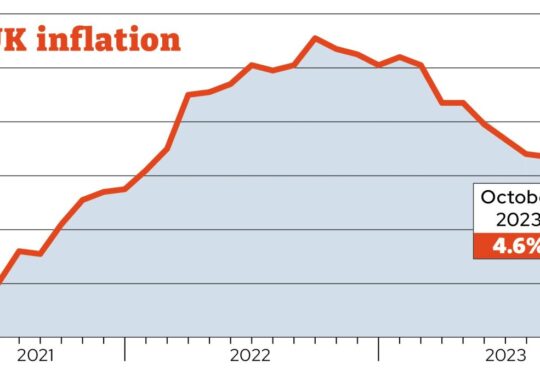Pension Benefit Guaranty Corporation—Use of Appropriations Provided in the American Rescue Plan Act of 2021 for Special Financial Assistance
Decision
Matter of: Pension Benefit Guaranty Corporation—Use of Appropriations Provided in the American Rescue Plan Act of 2021 for Special Financial Assistance
File: B-334541
Date: August 9, 2023
The Pension Benefit Guaranty Corporation (PBGC) made certain determinations regarding the interest rate that multiemployer pension plans should use to calculate eligibility for and amounts of special financial assistance (SFA) established by the American Rescue Plan of 2021 (ARPA).
Congress provided PBGC with an appropriation in ARPA for the costs of SFA. Under the purpose statute, appropriations are only available for the purposes for which Congress made them. PBGC used this appropriation for the purpose of SFA. PBGC’s actions do not violate either the purpose statute or the Antideficiency Act, notwithstanding questions about PBGC’s interest-rate calculations under provisions of the Employee Retirement Income Security Act of 1974 added by ARPA.
The American Rescue Plan Act of 2021 (ARPA) allowed financially distressed multiemployer pension plans to apply to the Pension Benefit Guaranty Corporation (PBGC) for special financial assistance (SFA). Pub. L. No. 117-2, title IX, subtitle H, § 9704, 135 Stat. 4, 190 (Mar. 11, 2021) (amending the Employee Retirement Income Security Act of 1974, Pub. L. No. 93-406, 88 Stat. 829 (Sept. 2, 1974) (ERISA) to include new section 4262). ARPA specified an interest rate for plans to use in determining their SFA eligibility and amounts. Id. In its Final Rule implementing ARPA’s SFA provisions, PBGC instructed SFA applicants to use ARPA’s specified interest rate for eligibility and amount calculations applicable to “non-SFA assets,” while using a separate interest rate for calculations applicable to “SFA assets.” Special Financial Assistance by PBGC, 87 Fed. Reg. 40968, 41007-41008 (July 8, 2022) (codified at 29 C.F.R. part 4262) (hereafter Final Rule). We received a request from PBGC’s Inspector General as to whether PBGC’s determinations regarding these interest rates exceeded PBGC’s “appropriations authority” under ARPA. Letter from Inspector General, PBGC to General Counsel, GAO (Aug. 10, 2022) (Request Letter). As discussed below, we conclude that PBGC used its ARPA appropriation for its stated purpose and as such, neither the purpose statute nor the Antideficiency Act are violated by PBGC’s interest rate determinations.
Our practice when rendering decisions is to contact the relevant agencies to obtain their legal views on the subject of the request. GAO, Procedures and Practices for Legal Decisions and Opinions, GAO-06-1064SP (Washington, D.C.: Sept. 2006), available at https://www.gao.gov/products/gao-06-1064sp. Accordingly, we reached out to PBGC to obtain the agency’s legal views. Letter from Assistant General Counsel for Appropriations Law, GAO, to General Counsel, PBGC (Sept. 21, 2022). We received PBGC’s response on November 4, 2022. Letter from General Counsel, PBGC, to Assistant General Counsel for Appropriations Law, GAO (Nov. 4, 2022) (Response Letter).
BACKGROUND
ERISA created PBGC to “encourage the continuation and maintenance of” private sector defined benefit pension plans and “provide for the timely and uninterrupted payment of pension benefits.” 29 U.S.C. § 1302(a). To this end, PBGC administers multiple insurance programs. See id. §§ 1302, 1305 (establishing multiple funds for PBGC to use with respect to retirement benefits guaranteed in ERISA). PBGC also provides financial assistance to distressed multiemployer pension plans that participate in its Multiemployer Insurance Program. See id. § 1431.
ARPA amended ERISA to establish an additional fund for PBGC to provide “special financial assistance” to certain multiemployer pension plans. See Pub. L. No. 117-2, § 9704, 135 Stat. at 190; 29 U.S.C. § 1305(i). Additionally, ARPA describes eligibility for SFA and application requirements through newly created section 4262(e) of ERISA. Pub. L. No. 117-2, 135 Stat. at 190, 191, 192.
ARPA provided PBGC with an indefinite appropriation to carry out these SFA provisions:
There is appropriated from the general fund such amounts as are necessary for the costs of providing financial assistance under section 4262 and necessary and administrative and operating expenses of the corporation. The [SFA] fund established under this subsection shall be credited with amounts from time to time as the Secretary of the Treasury, in conjunction with the Director of the Pension Benefit Guaranty Corporation, determines appropriate, from the general fund of the Treasury, but in no case shall such transfers occur after September 30, 2030.
Pub. L. No. 117-2, § 9704(a).[1]
ARPA directed PBGC to “issue regulations or guidance setting forth requirements for [SFA] applications” within 120 days of the ARPA’s passage. Pub. L. No. 117-2, § 9704, 135 Stat. at 191; 29 U.S.C. § 1432(c). In its Interim Final Rule implementing this provision, PBGC indicated that multiemployer pension plans could not use interest rates other than the rate specified in section 4262(e). Special Financial Assistance by PBGC, 86 Fed. Reg. 36598, 36602 (July 12, 2021) (Interim Final Rule). In its Final Rule dated July 8, 2022, however, PBGC instructed plans to use separate interest rates depending on whether their eligibility and amount calculations involved “non-SFA assets” or “SFA assets.” Final Rule, at 41007–41008.
PBGC acknowledged that its separate rate for SFA assets was different from the rate specified in section 4262(e). Response Letter, at 4. However, PBGC explained its determination that directing plans to use a separate rate for SFA assets was necessary to harmonize section 4262(e) with the provisions in sections 4262(j) and (l) requiring the payment of SFA in amounts sufficient to “pay all benefits due” and the segregation of SFA and non-SFA assets. Final Rule, at 40973. According to PBGC, its use of separate rates, along with other changes specified in the Final Rule, will result in an estimated $4.4 billion increase in SFA payments above what its Interim Final Rule would have allowed. Response Letter, at 8.
DISCUSSION
At issue here is whether PBGC used the ARPA appropriation for its provided purpose notwithstanding questions about PBGC’s interest rate determinations.
Under the purpose statute, appropriations may be used only to achieve the purposes for which they were appropriated. 31 U.S.C. § 1301. When interpreting an appropriation’s purpose, we begin by looking to the language of the statute. B-325630, Sept. 30, 2014. However, we do not read the purpose statute to require that every item of expenditure be specified in an appropriation. Id.; see alson B-285066.2, Aug. 9, 2000 (finding that the Inspector General of the Department of Housing and Urban Development (HUD) had authority to fund a gun-buyback program given general appropriation authorizing activities to combat violent crime). Rather, when an appropriation does not specifically identify the expense in question, we apply a three-part necessary expense rule to determine whether the appropriation is available. Under this rule, an appropriation is available for an expense that (1) bears a reasonable, logical relationship to the purpose of the appropriation; (2) is not prohibited by law; and (3) is not otherwise provided for.
B-333826, Apr. 27, 2022.
Here, steps two and three of the necessary expense rule are not at issue, as Congress did not prohibit PBGC payments relative to SFA, nor did it provide other appropriations that are arguably available for the SFA expenses at issue. Accordingly, our analysis focuses on step one.
Under step one of the necessary expense rule, agencies generally have discretion to determine whether expenditures are reasonably related to the purposes of their appropriations. B-329373, July 26, 2018. “[T]he question is whether the expenditure falls within the agency’s legitimate range of discretion, or whether its relationship to an authorized purpose or function is so attenuated as to take it beyond that range.” B-333826. Thus, in one recent case, we found that the Election Assistance Commission (EAC) could permit the use of grant funds under the Help America Vote Act of 2002[2] to provide security and threat-monitoring services to local election officials. Id. As we found, EAC’s appropriation broadly authorized activities “to improve the administration of elections,” and EAC “could reasonably conclude” that providing security and threat-monitoring services would yield such improvements. Id. at 2, 6.
Additionally, under step one of the necessary expense rule, the determination of an appropriation’s authorized purpose is informed by relevant authorizing and program legislation. For instance, a Centers for Medicare and Medicaid Services (CMS) annual appropriation provided funds and authorized the collection of fees for use in carrying out a list of enumerated statutes and “other responsibilities of the [CMS]”. B-325630. After Congress separately required CMS to establish a “risk corridors” program to stabilize insurance markets pursuant to the Patient Protection and Affordable Care Act (ACA), 42 U.S.C. § 18062, we found that CMS’s appropriation and fee-collection authority were available to cover expenses of this new program. B-325630. As we explained, “existing agency appropriations that generally cover the type of expenditure involved are available for expenses of new or additional duties imposed by proper legal authority.” Id. (citing B-290011, Mar. 25, 2002, 15 Comp. Gen. 167 (1935)). The ACA, as a new legal authority, informed the scope and availability of HHS’s appropriation, including by making that appropriation available for ACA-mandated programs.
GAO’s determinations in a pair of cases implicating gun-buyback programs are also instructive. In the first case, we found that HUD lacked authority to fund a gun-buyback program as part of its Public Housing Drug Elimination Grants Program (PHDEG). B-285066, May 19, 2000. As we explained, the underlying PHDEG statute only addressed drug-use, not the reduction of drug-related crime, which was HUD’s stated purpose for initiating the gun-buyback program. Id. Thus, HUD could not use the lump-sum appropriation that Congress provided for the PHDEG program for expenses associated with gun-buyback. Id. (“While HUD relie[d] upon evidence of a relationship between guns and violence and guns and drug dealing,” this was not sufficient to establish a necessary expense under the purpose statute.). Id. In the second case, we found that HUD’s Office of Inspector General (OIG) did have authority to fund a gun-buyback pursuant to its Operation Safe Home program. B-285066.2. Congress had set aside certain funds for the purpose of enabling OIG “to combat violent crime in public and assisted housing under the Operation Safe Home program.” Id. at 2. The Operation Safe Home program did not have a separate authorizing statute, so operation of the program and use of the funds was governed by the language of the appropriation set-aside itself, which we determined was broad. Id. at 4. OIG’s use of funds for gun-buyback was consistent with the authority provided to OIG in the appropriation set-aside, which was broader than HUD’s authority under the PHDEG statute. Id. at 5 n.5.
A somewhat different situation arose in B-334146, June 5, 2023. There, the U.S. Department of Agriculture (USDA) implemented new agency rules without following the Congressional Review Act (CRA) requirement for agencies to submit a report to Congress and the Comptroller General before covered rules can take effect.
5 U.S.C. § 801(a)(1)(A). GAO was asked to consider whether USDA’s use of appropriated funds toward the implementation of these rules was impermissible as to purpose (and therefore violated the Antideficiency Act) considering that USDA had not followed CRA. See B-334146. We found no appropriations law violation. As we explained, USDA’s ability to obligate appropriations was not “contingent on [its] compliance with the requirements of the CRA.” Id. at 15. Congress had not “restricted” USDA’s use of funds “to a specific outcome in applying the CRA.” Id.
Here, by reference to the above cases, we find no violation of the purpose statute. Congress provided PBGC with a broad and indefinite appropriation for “such amounts as are necessary for the costs of providing financial assistance under section 4262,” as well as “necessary administrative and operating expenses.” Pub. L. No. 117-2, § 9704(a). PBGC’s expenses at issue, regardless of the interest rate used to calculate them, are for the purpose of “providing financial assistance under section 4262.” Id.; Response Letter, at 11, 13. This is not a situation comparable to HUD’s use of PHDEG funds to reduce crime instead of their intended purpose to reduce drug use. Similar to HHS in B-325630, the new ERISA provision informed the purpose availability of PBGC’s ARPA appropriation for costs associated with providing SFA, however, the appropriation did not specifically condition the availability of funds on the manner in which PBGC applied the provisions of section 4262 to calculate the amounts necessary. See B-334146. Like the EAC in B-333826, and like HUD’s OIG in B-285066.2, PBGC’s determination that its appropriation was available for the costs of SFA as determined by PBGC through applying section 4262 (understanding that different interest rates may result in different amounts of SFA), was a reasonable exercise of its discretion.
Even where an expenditure is permissible from a purpose standpoint, the Antideficiency Act prohibits agencies from obligating or expending in excess or in advance of an appropriation unless otherwise authorized by law. 31 U.S.C. § 1341(a)(1). However, for agencies with an indefinite appropriation, it is not possible to spend excess amounts on an authorized purpose. See B-328450, Mar. 6, 2018. But see B-326013, Aug. 21, 2014 (explaining that no amount is available for an unauthorized purpose).
Here, considering that PBGC’s expenses were for an authorized purpose and that Congress provided an indefinite appropriation, we find no violation of the Antideficiency Act. PBGC’s appropriation did not specify any maximum amount for the necessary “costs of providing financial assistance under section 4262.” Pub. L. No. 117-2, § 9704(a). Thus, even accepting PBGC’s projection that its use of separate interest rates and related changes will create a $4.4 billion increase in SFA payments, this would not exceed any amount specified in PBGC’s appropriation.
We do not reach the issue of whether PBGC’s actions were consistent with ERISA or any other non-appropriations provision by directing plans to use an interest rate other than the one specified in that Act. As explained above, we hold only that PBGC’s interest rate determinations did not cause any violation of the purpose statute or the Antideficiency Act. Any possible inconsistency of PBGC’s actions with non-appropriations provisions does not upset our holding. See B-334146 (noting that the Antideficiency Act does not “require agencies to report violations of other laws, nor does it require agencies to report improper practices that do not result in violations of the Antideficiency Act”).
Given the above considerations, we also do not reach PBCG’s arguments that separate interest rates are necessary to harmonize ARPA’s new ERISA provisions, or that PBGC’s interpretation of ERISA is entitled to deference under Chevron, U.S.A., Inc. v. Natural Resources Defense Council, Inc., 467 U.S. 837 (1984), and other Supreme Court decisions. Response Letter, at 5, 11–12. For present purposes, Congress’s broad and indefinite appropriation to PBGC in ARPA is sufficient to resolve any questions of appropriations law.
CONCLUSION
Congress provided PBGC with a broad and indefinite appropriation for the costs of SFA. Notwithstanding questions about its calculation of interest rates, PBGC used its appropriation for SFA. Thus, we find no violation of the purpose statute or the Antideficiency Act.
Edda Emmanuelli Perez
General Counsel






